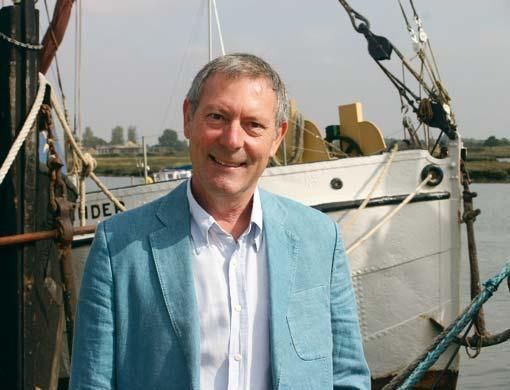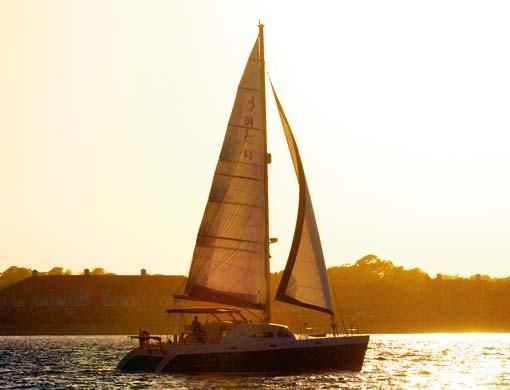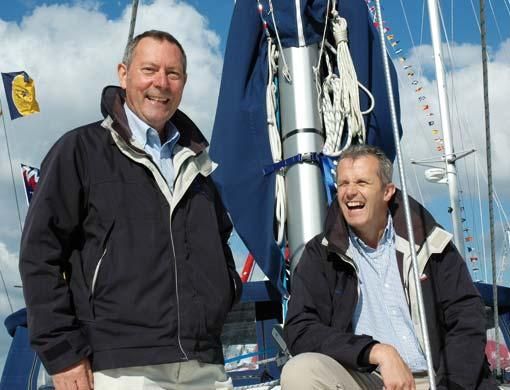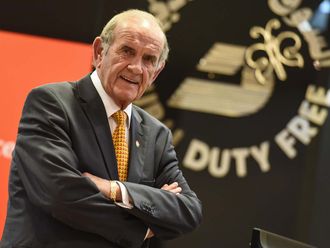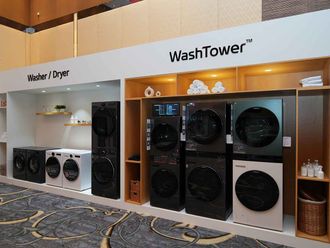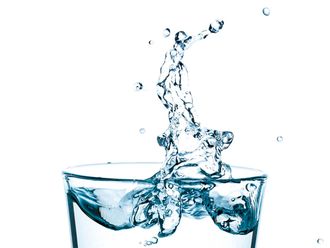At the age of 4, Robert Underwood leapt into a dinghy and set off down a creek by himself. And so a life as a mariner was born! Today he designs and produces catamarans then has the pleasure of testing them, writes Shalaka Paradkar
It's a boat with a hoary history stretching all the way back to the fifth century, the time of the Tamil Chola dynasty in India. The Cholas used catamarans to conquer much of Southeast Asia, including Myanmar, Indonesia and Malaysia.
These sleek, twin-hulled boats were invented by South India's paravas, a fishing community. In fact, the word catamaran has Tamil origins: from Tamil kattu 'to tie' and maram 'wood' or 'tree'.
While its name comes from Tamil, the modern catamaran as we know it originates in the South Pacific. In the 17th century, English seafarers applied the name catamaran to the fast, stable boats made out of two separated logs that Polynesians paddled or sailed from one island to another.
The design remained relatively unknown in the West for almost 200 years, when American Nathanael Herreshoff
began to build catamarans in the late 19th century.
The speed and stability of these twin-hulled boats made them a popular pleasure craft in Europe and the US. Then in 1947, surfing legend 'Woody' Brown and Alfred Kumalae designed and built the first modern ocean-going catamaran, Manu Kai, in Hawaii.
Two years later, the Prout brothers, Roland and Francis, began to experiment with making catamarans in the UK. In 1954 they converted their Essex boat factory and geared it to manufacture catamarans.
In races, their Shearwater catamarans made a mockery of single-hulled yachts. They went on to produce the first modern production catamarans.
Robert Underwood is the direct heir to the legacy of the Prout brothers.
A friend and colleague of the famous pair, he has designed and built eight generations of catamaran hull designs over the past 30 years. Born in Essex to a family that lived and breathed boats, he is today one of the most experienced catamaran sailors, designers and builders in the world.
As a teenager, Underwood raced catamarans. "They seemed more enjoyable to sail and master than conventional boats,'' he recalls.
It was while racing 'cats' that he solidified a friendship with the Prout brothers, which later led to a partnership.
He took over the business when Roland and Francis Prout retired and developed it into one of the most successful and largest catamaran builders in the world.
However, when Prout was bought by Quest (a subsidiary of the Canadian Winfair group) in July 2000, Underwood found himself at odds with the new management.
So in the summer of 2002, he and his friend Mark Elliot founded Broadblue Catamarans, a catamaran design and manufacturing company. Since then he has assisted in developing the Broadblue Catamaran range and some 60 of these are sailing in different parts of the world.
Involved with the design and manufacture of ocean-going catamarans since 1975, Underwood along with Elliot has been instrumental in the manufacture of over 1,000 'cats'.
Underwood is a qualified electronic engineer who worked as navigator on seismic survey vessels before becoming involved with catamarans.
The son of a marine engineer, he grew up surrounded by boats and has sailed and raced dinghies, beach catamarans, such as Shearwaters, Hurricanes, Tornados and old barge yachts, through to the highest performance Formula 40 racing catamarans and even a 62-foot performance trimaran.
He has also owned a number of cruising catamarans, from 34-foot to 50-foot, and has raced them extensively.
He has been involved in the design, engineering and production of more than 1,500 catamarans, including the Panther range of power catamarans which culminated in the spectacular Panther 64 foil-assisted catamaran that is capable of over 45 knots - a record of sorts unsurpassed to date, Underwood says.
I
I have a love of the sea since a very early age. I always wanted to be on the water, ever since I was a child. Being on the water calms me down.
I single-handedly built my first yacht, a Prout 45 Ocean Ranger, from 1973 to 1975. I raced it to the Azores (a Portuguese archipelago in the Atlantic Ocean) in one of the first multihull ocean races.
Catamarans have always been my passion. I love sailing them. Most weekends, my family and I take off on a cat - they won't sail on anything else. They like the fact that it's stable, comfortable, there's lots of deck space and room below to enjoy.
The most memorable race I participated in was the one called the Three Peaks Race. In this, you have two mountain runners on board and you sail between the three highest mountains in England, Wales and Scotland.
They run up the mountains and back into the boat. It's an unusual race, in that you sail all night and get them to the mountain. I did this race four times in the early 1990s. I have also raced in the Azores.
Nowadays I am a bit soft, so I prefer sailing off Greece, Turkey and in the Mediterranean. But I like sailing everywhere. I am getting used to sailing here in the Gulf, but not in these temperatures.
I once got shipwrecked on one of the Thames estuaries in Essex, when the anchors dragged and the boat got washed ashore. I was beached for more than two weeks.
The conditions were very stormy, we had to wait for the next high tide and dig trenches in the meantime to get the boat afloat.
ME
Me and my childhood:
I belong to a sailing family. My father was a marine engineer who ran a number of boatyards before and after the Second World War.
I was born on the east coast of England in a little place called Benfleet in Essex. I have been around boats since I was a tiny baby. My family comprised my parents, my sister, Gail, and I. All of us sail and have had boats over the years. We have always sailed along the Thames and its estuaries.
It was a very free childhood. My parents, though, had a few scary moments when I was out on the water. When I was about 4 years old, I cast myself adrift on a dinghy and went sailing down the river. My parents had to chase after me. Even in those days, I was always game for a bit of adventure.
My father died when I was 11. We moved to another place and I took up sailing again. By the time I was 16,
I was sailing in the North Sea, cruising around the European coast in little boats.
Between the age of 16 and 22, I owned a variety of small catamarans, which I would race. At that age, it was the speed of the boats that attracted me. Catamarans were very fast, very exciting to sail and easy to handle.
I trained as an electronics engineer and went to work for Marconi (Electronic Systems). Telecommunications interested me, but it wasn't my passion.
Gradually my interest in boats changed from an exciting and adventurous pastime to a potential business. This was after having spent a couple of years working abroad as an engineer.
When I returned in 1973, I had sufficient money to build my first big boat. I was about 22 then. It was a 45-foot catamaran, which was quite unusual in those days.
Catamarans were not mainstream boats. I built it virtually from scratch. I was always attracted to the idea of catamarans. We lived in Essex where the Prout brothers worked. My family had some connections with them.
I started meeting them at various places where I sailed. My passion for catamarans was ignited when I started sailing with them.
Me and the Prout brothers:
I raced with Roland Prout in small 16-foot catamarans. Once I was on one of these boats, I didn't want to do anything else. Roland and Francis were highly adept in designing catamarans.
From 1953 and onwards, they had pioneered all the modern principles of catamarans. They started off by joining two racing canoes together; that idea became the first small successful racing catamaran, the Shearwater.
Then they made the first cruising catamarans, the 36-foot cold moulded design. (Cold moulding uses glue and employs vacuum pressure and heat to amesh wood or other materials.)
In 1961 they built the first all-glass fibre production catamarans, the Ranger 27/31 and went on to develop the modern hull shapes, the first low aspect ratio keels and the structures that make modern catamarans safe and strong.
Since I was sailing with them, we became very close. In my twenties, I left my job as an electronics engineer and started selling catamarans. Then in 1975 the Prouts brother and I formed a company together, as they were getting older and running out of steam.
Together we (came up with) many new designs and between us produced more than 4,500 catamarans of all sizes.
They taught me a lot about the structural design of a catamaran - the basic stuff that still stands us in good stead today. A lot of the hull forms that the Prouts pretty much invented in those early years (the mid-1950s to early-1970s) are copied by the competition today.
I also learned a lot of business skills and salesmanship from them. They were good businessmen - and fair. They knew how to run a reasonably large factory. So I gradually inherited those skills from them, learning from their vast experience. We built the company into a fairly substantial business in the UK.
Me and the turning point:
I had two financial partners, one American and the other British. In the 1990s, the company was investing in some big power catamarans. (We built some three or four of these in Dubai - big 64-foot cats.)
That was a very expensive project in terms of investment in design and engineering. But the market in the US began to slide; we weren't selling many boats there and our American partner decided to pull out of the business.
We found a buyer for the business at that point. It was decided I would stay on and run it. So we sold the business to a Canadian group. I stayed on for a few months, but I did not get on with the new management.
I was used to running my own ship. So I left to start Broadblue Catamarans with my friend and partner Mark Elliott. Mark also has a passion for boats.
We had to start from scratch, designing new products, getting them built and setting up factories.
And, of course, like all new ventures it had its own teething problems: things didn't run on time, the factories needed extra attention … the factories for the smaller boats were in Poland, since it offered a competitive advantage in terms of labour and overhead costs, then we assembled these in Essex.
Me and catering to the cat customer:
We have had a number of demanding customers over the years, and still do. Which is as it should be, since we build a luxury product. We do a lot of customising - and those customers who are willing to pay more are used to getting what they want.
So there can be some tussles and you have to just work it out. In the early days, one of our customers demanded a jacuzzi on the deck. Nowadays, it's not that uncommon to find one on a big boat.
We have had clients opt for quite strange colour schemes for the interiors. One of our boats had an all-black interior, complete with black satin sheets. The owner was a jazz singer in a band.
I personally have built about 1,500 ocean-going cats. The range of 50-foot cats we built, the Quasar, were the most special. It was a very successful model in those days when big cats were quite rare. We built about 50 of them.
The other project very close to my heart was the Panther range we did about 11 years ago, they (featured) some groundbreaking technology in hull design.
MYSELF
What are the biggest challenges and frustrations in your business?
The kind of problems I have faced are the ones any business faces - cash flow issues and getting boats out in time. You have ups and downs in any business, which is frustrating. And the boat business is no different.
But the big advantage is that we love what we do. Every product we turn out reflects that passion. Mark Elliott and I started the business and have built it up. As the company grows, we have needed more investment funds to set it up. We now have new partners this year.
We started in Dubai some 12 years ago and are confident the market is going to accelerate here. We sell yachts here through Nick Jerromes at Jerroco, which operates out of Jebel Ali.
I have always loved my work and am as passionate about it now as I was when I first started. Overall, I am happy with the way the business has gone. It's very well set for the future.
Why do you love catamarans so much? Who would you recommend them to?
Catamarans are good, flat and stable boats. They don't keel or falter much and hence are great for families. Their cockpits and saloons are big and the cabins provide a good deal of privacy.
They offer a lot of space as compared to a monohull of the same size. You would need a 60-foot monohull to give you the same amount of space as a 40-foot cat and you would still miss out on all these other attributes.
They are also great for people who want to live in their boats as they are built for bluewater cruising, and ideal for corporate entertainment.
Catamarans are taking a bigger share of the market every year … they are getting established in all the big markets now. The US and European markets are very big on them and we are making headway in the Far East too. And, of course, in Dubai - as marina berths develop.


